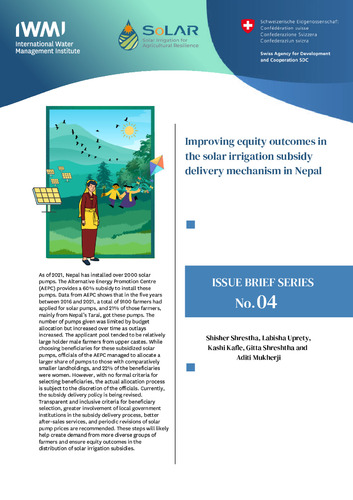Improving equity outcomes in the solar irrigation subsidy delivery mechanism in Nepal
Abstract
As of 2021, Nepal has installed over 2000 solar pumps. The Alternative Energy Promotion Centre (AEPC) provides a 60% subsidy to install these
pumps. Data from AEPC shows that in the five years between 2016 and 2021, a total of 9100 farmers had applied for solar pumps, and 21% of those farmers, mainly from Nepal’s Tarai, got these pumps. The number of pumps given was limited by budget allocation but increased over time as outlays
increased. The applicant pool tended to be relatively large holder male farmers from upper castes. While choosing beneficiaries for these subsidized solar pumps, officials of the AEPC managed to allocate a larger share of pumps to those with comparatively smaller landholdings, and 22% of the beneficiaries were women. However, with no formal criteria for selecting beneficiaries, the actual allocation process is subject to the discretion of the officials. Currently, the subsidy delivery policy is being revised. Transparent and inclusive criteria for beneficiary
selection, greater involvement of local government institutions in the subsidy delivery process, better after-sales services, and periodic revisions of solar pump prices are recommended. These steps will likely help create demand from more diverse groups of farmers and ensure equity outcomes in the distribution of solar irrigation subsidies.

